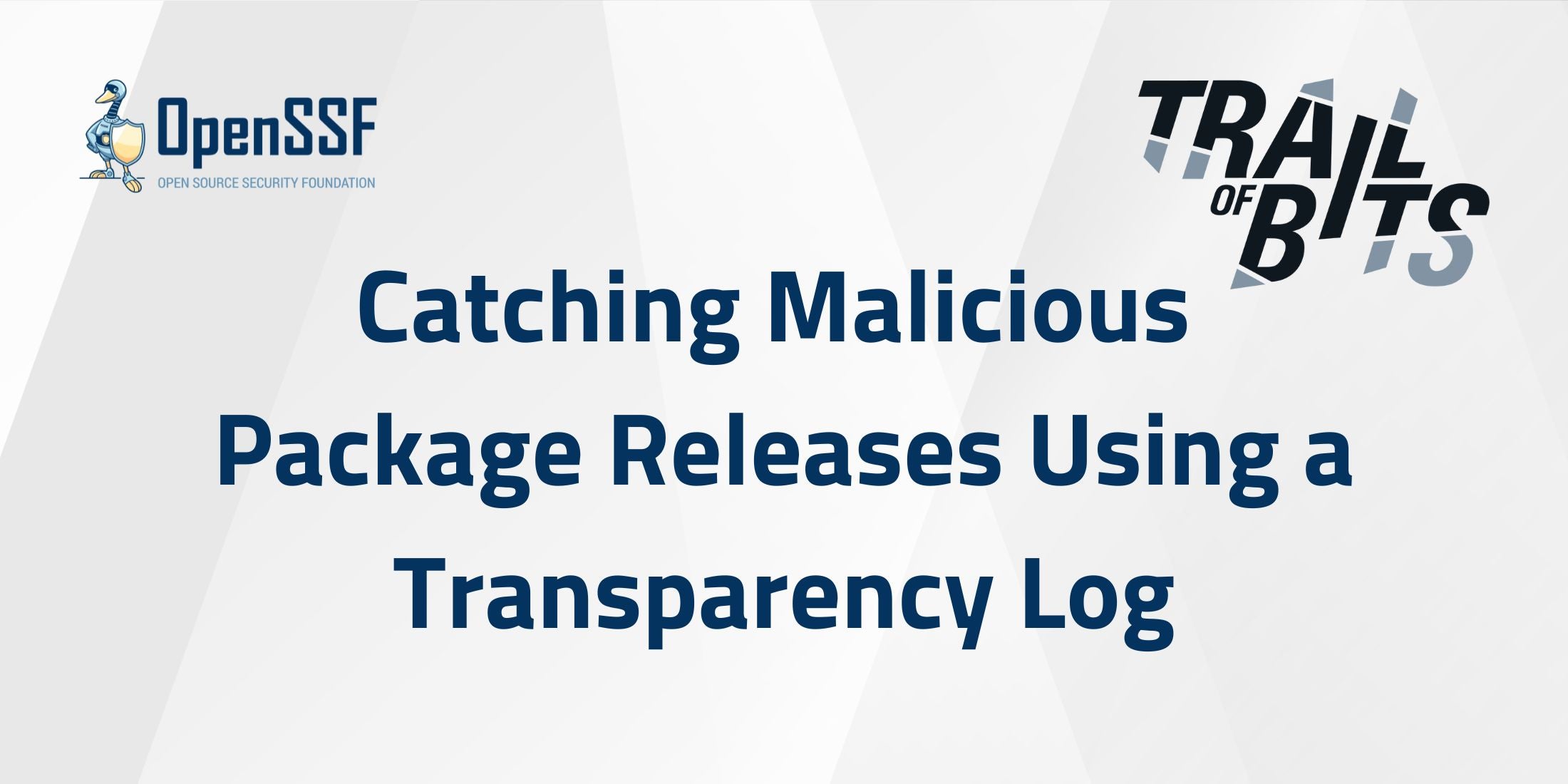



Welcome to the December 2025 edition of the OpenSSF Newsletter! Here’s a roundup of the latest developments, key events, and upcoming opportunities in the Open Source Security community.
🎁 2025 OpenSSF Annual Report
🎁 Free OpenSSF and Linux Foundation Education Courses
☃️ Recap: OpenSSF Community Day Korea 2025
☃️ KubeCon Keynote Recap
☃️ OpenSSF at OSPOlogyLive Europe
☃️ New podcast episodes (#46–47): AI, open source & collaboration (Jay White, Microsoft) and supply chain security in academia (Justin Cappos, NYU)
❄️ Alpha-Omega strengthened SBOM tooling and FreeBSD security
❄️ Gemara site launched
❄️ SecurityCon NA session videos now online
❄️ SLSA v1.2 adds a new Source Track
❄️ OpenBao v2.4.4 released
❄️ Upcoming events: FOSDEM (31 Jan & 1 Feb 2026), Open Source SecurityCon (23 March 2026), KubeCon+CloudNativeCon Europe (23-26, March 2026)
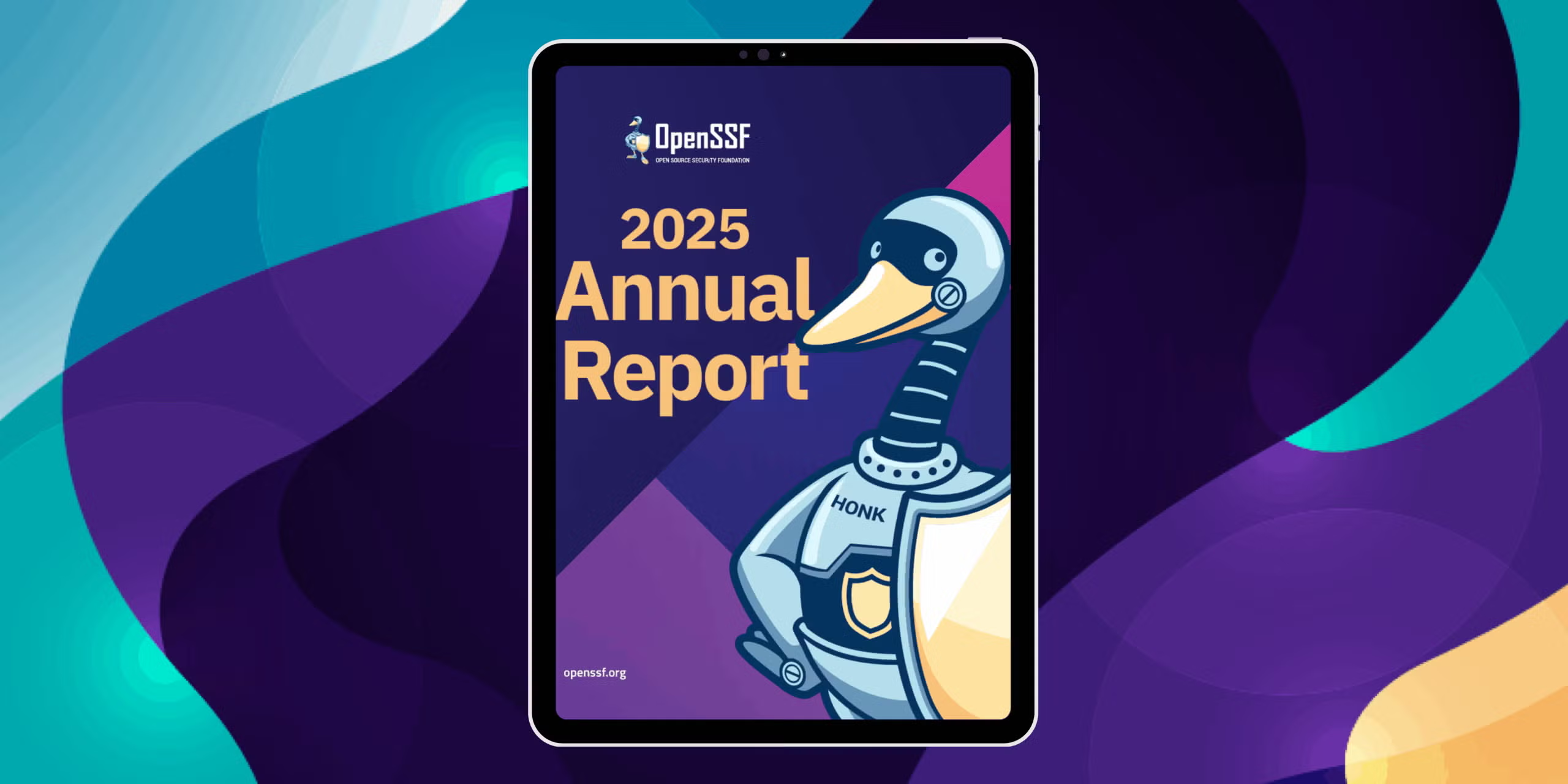
Discover how the open source security community moved forward in 2025. The OpenSSF Annual Report highlights major achievements in education, tooling, vulnerability management, research, and global collaboration with insights from leadership and working groups. It’s a powerful look at how far we’ve come and where we’re headed as we work together to strengthen the security of open source software.
Download the 2025 OpenSSF Annual Report and explore the progress, impact, and vision shaping the future of open source security.
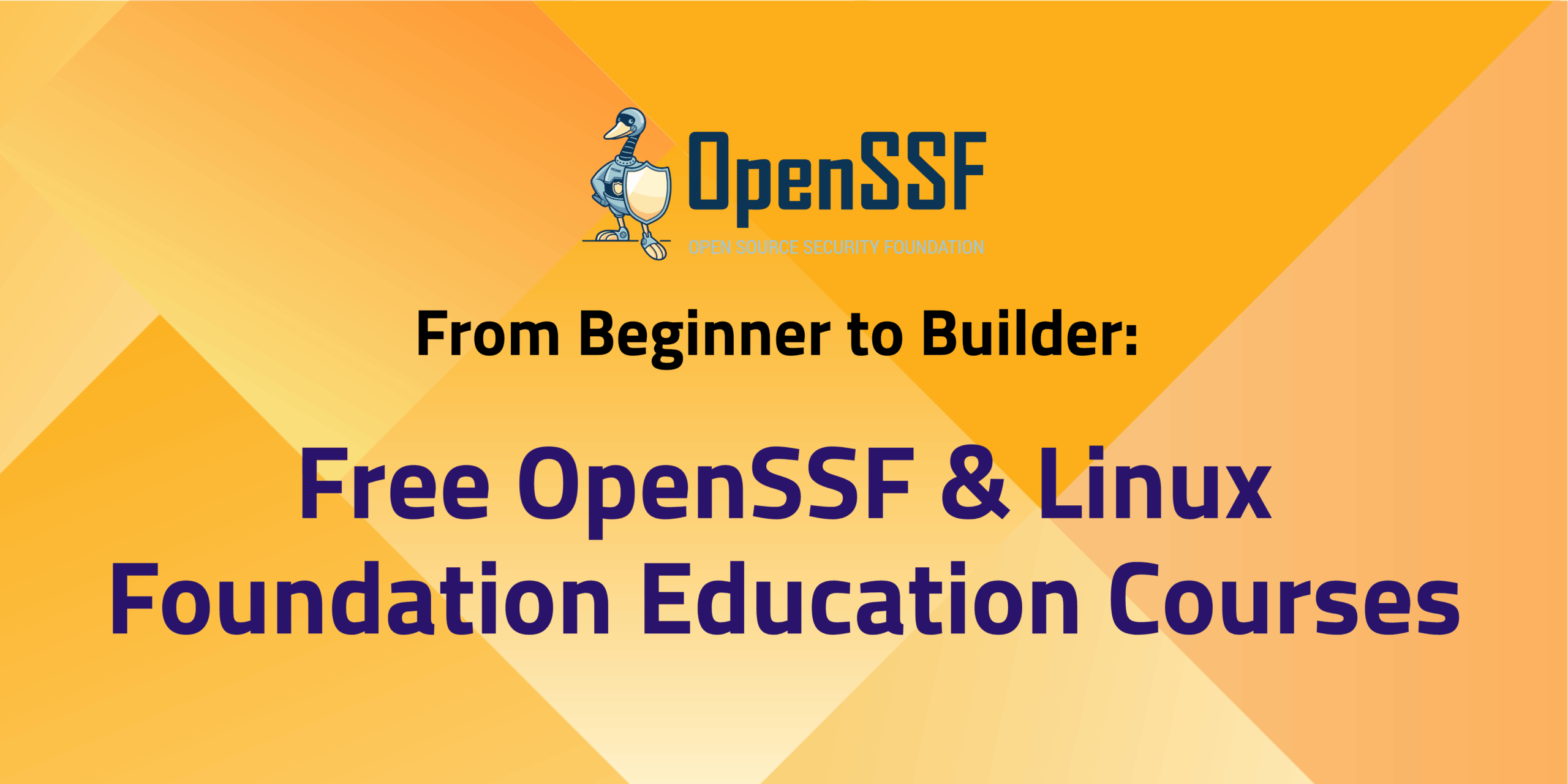
Level up your open source security skills with this practical roundup from Ejiro Oghenekome and Sal Kimmich, CSM, a curated list of free, self-paced Linux Foundation Education and OpenSSF courses built for developers who want to contribute with confidence. From secure coding and threat modeling to OpenSSF Scorecard automation, SBOMs/signatures, and even essential context like ethics, inclusion, and new regulations, this blog post maps out clear learning paths you can start right away, before (or alongside) your next contribution. Read the blog.
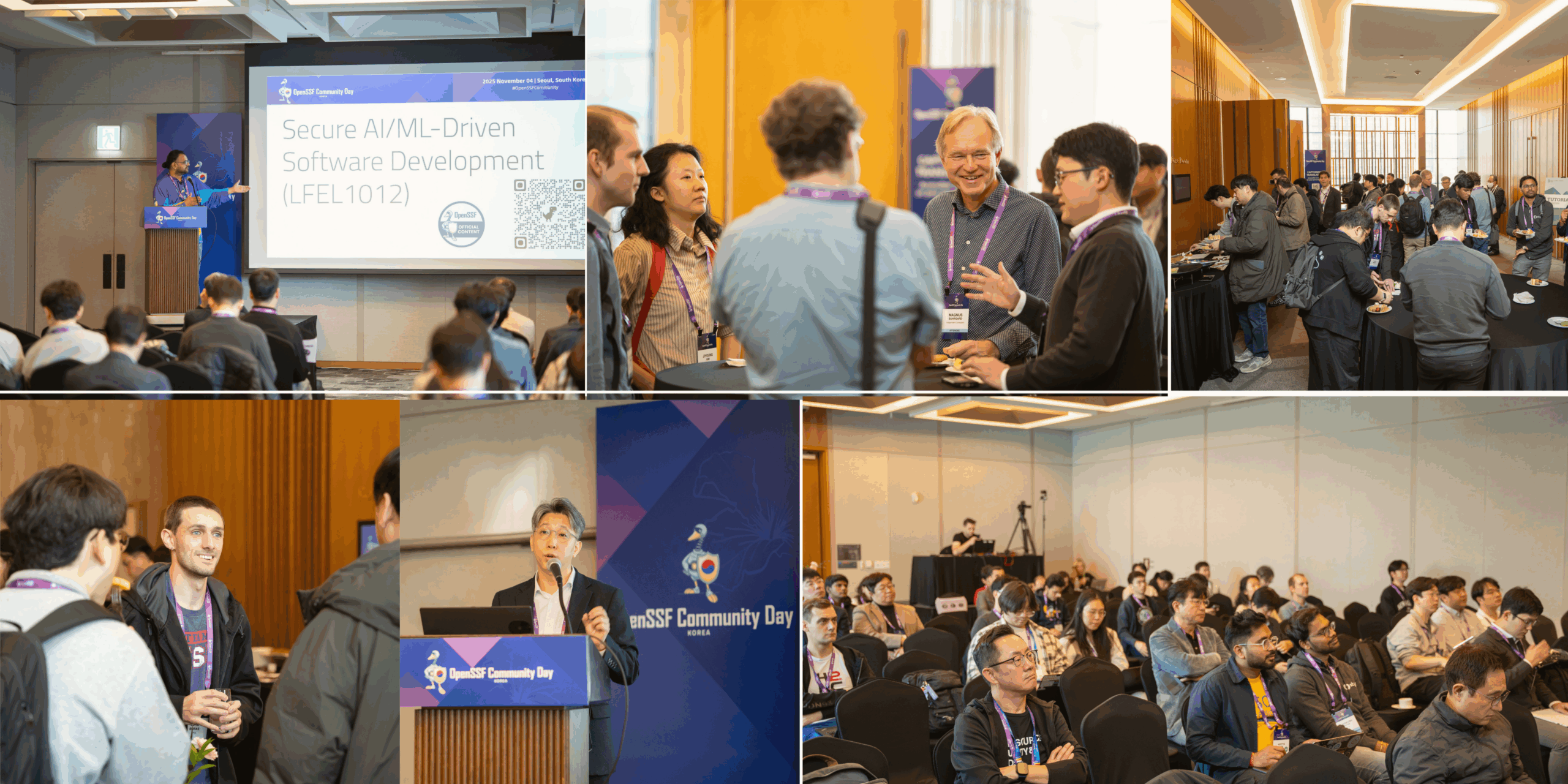
OpenSSF Community Day Korea 2025, held on November 4 in Seoul, brought developers and security engineers together for practical sessions on open source and software supply chain security. Talks spanned CI/CD hardening, SBOM-driven tooling, Linux kernel testing, post-quantum cryptography, and AI/ML security, all framed by OpenSSF’s pillars of Education, Policy, Projects, and Community. The event marked a strong start for a growing OpenSSF community in Korea, with public, private, and academic stakeholders aligning around the message that securing open source is shared work. Read the recap blog.
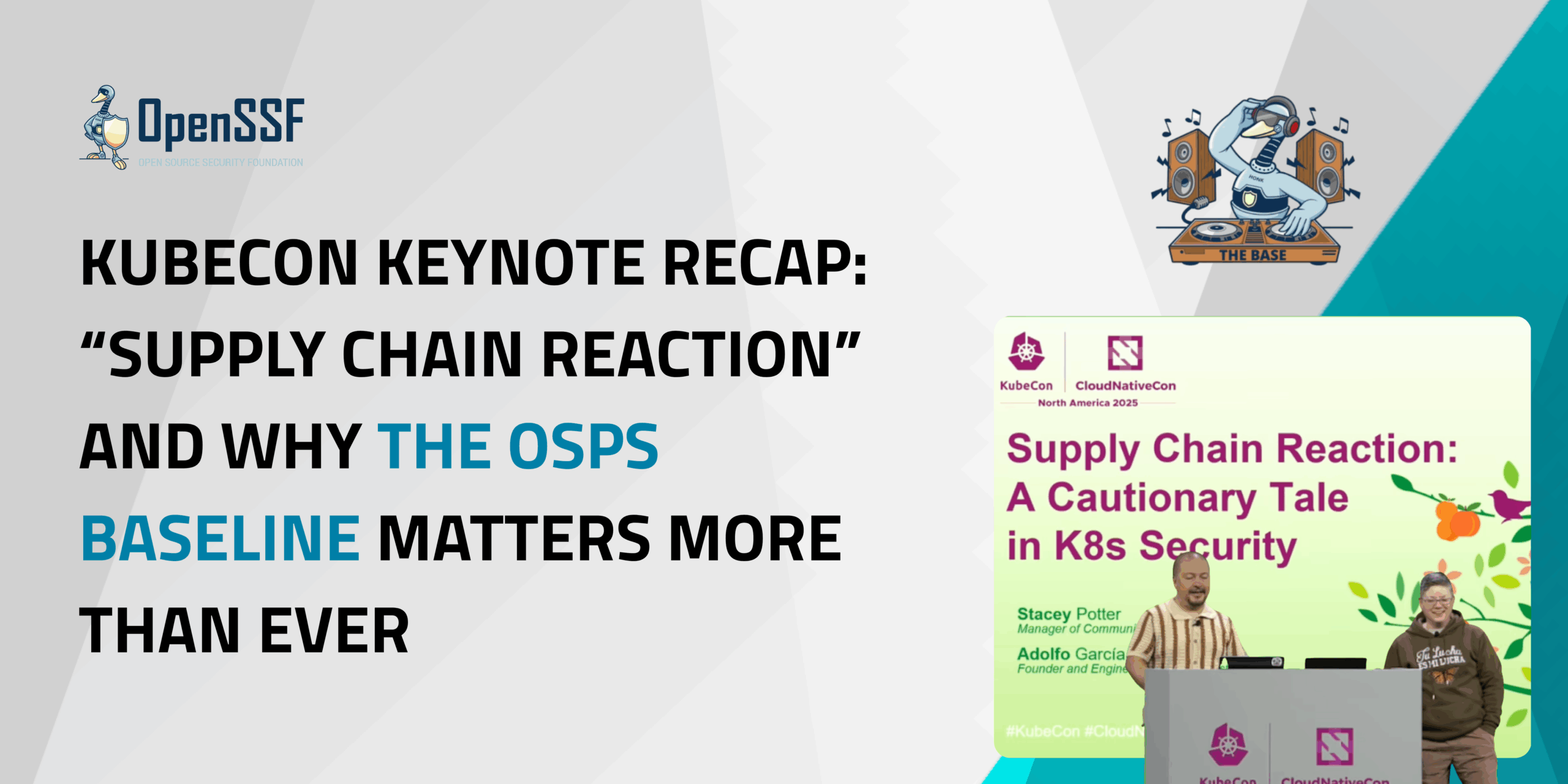
How can a Kubernetes cluster with zero known vulnerabilities still be compromised?
In their KubeCon keynote “Supply Chain Reaction: A Cautionary Tale in K8s Security,” Stacey Potter (Community Manager, OpenSSF) and Adolfo García Veytia (Founder and Engineer, Carabiner Systems) walked through a realistic incident where a compromised compiler image injected a crypto-mining payload long before workloads reached the cluster, bypassing traditional defenses. They showed how tools like SLSA, Sigstore, Kyverno, and Ampel help secure the entire software lifecycle, and why the new Open Source Project Security (OSPS) Baseline with its eight control families and three maturity levels gives projects a practical, stepwise framework to resist invisible supply-chain attacks.
The talk makes a clear case: adopting the OSPS Baseline is now essential for any open source project that wants real, preventative supply-chain security. Learn more.
Short on time but curious about open source security tools? This video series features quick interviews with OpenSSF maintainers, giving you a fast, developer-focused look at the projects, standards, and initiatives they’re building. Hear directly from the people behind the code and discover which tools you might want to try next. Watch the videos here.
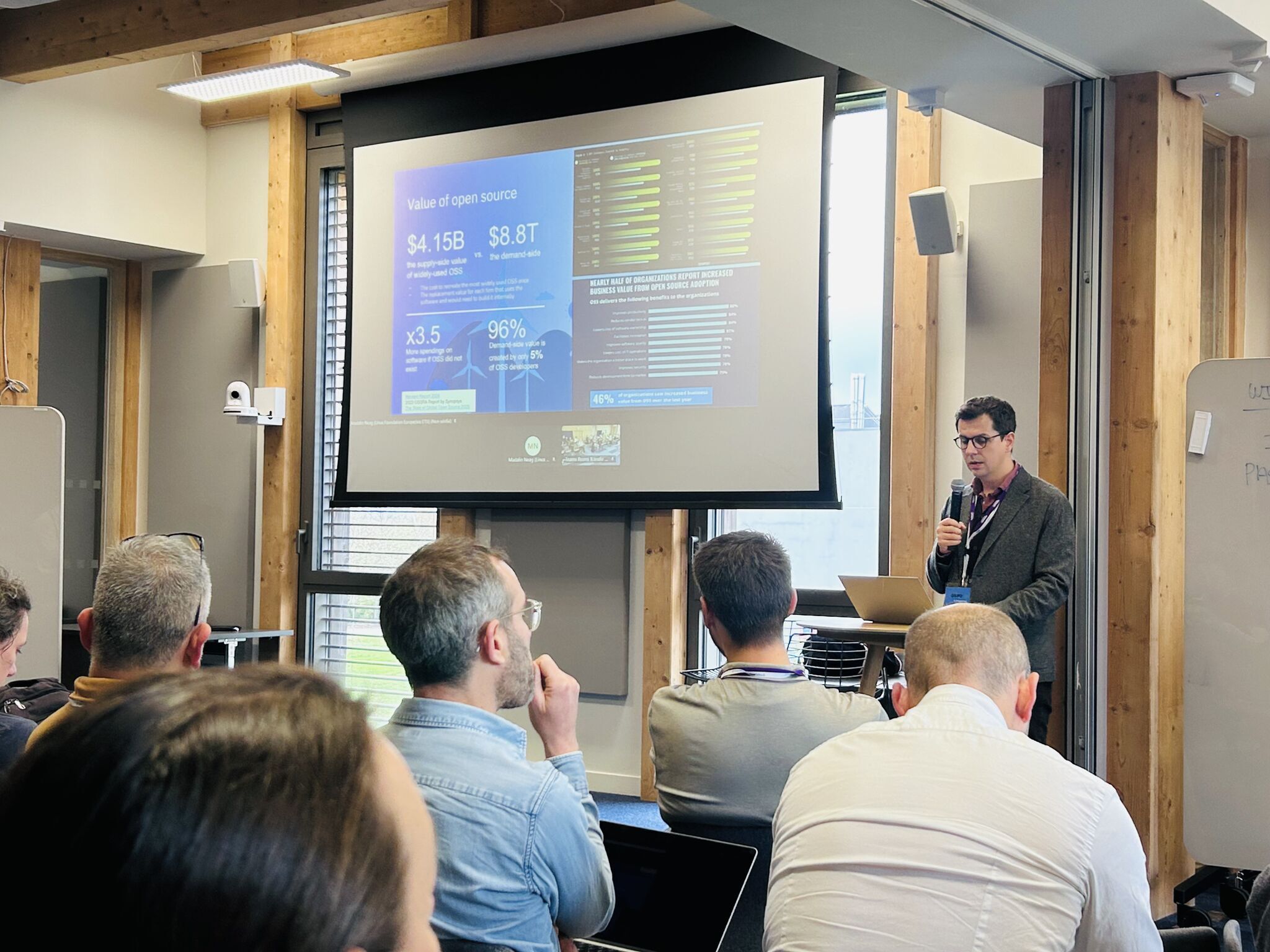
Madalin Neag, EU Policy Advisor at OpenSSF participated in OSPOlogyLive Europe, where he presented The Cybersecurity Skills Framework presentation and discussed why securing software requires investing in people and shared security knowledge, not just technology. The session highlighted OpenSSF’s leadership in building practical, role-based security capabilities across engineering teams. The framework provides a clear, actionable map for identifying security skill gaps and prioritizing capability development across the software ecosystem. It also demonstrated how organizations can use a common language for security skills to systematically improve their cybersecurity posture.”
#47 – S2E24 Teaching the Next Generation: Software Supply Chain Security in Academia with Justin Cappos
On the latest episode of What’s in the SOSS, host Yesenia Yser sits down with Justin Cappos, professor at NYU Tandon School of Engineering, to discuss why software supply chain security is still missing from many university curricula and how hands on, open source first education can better prepare students for real world security work.
The conversation explores gaps in traditional computer science education, the importance of teaching open source collaboration, and how initiatives like the Linux Foundation’s Academic Computing Accreditation Program are helping institutions modernize security education.
🎧 Listen to the episode and learn more about the Academic Computing Accreditation Program: https://www.linuxfoundation.org/academic-computing-accreditation
#46 – S2E23 Securing the Future: AI, Open Source, and Collaboration with Jay White (Microsoft)
In this episode of What’s in the SOSS? Jay White from Microsoft’s Azure office of the CTO joins to talk about his path into open source and how it led him to focus on AI, machine learning, and security. He explains how model signing and transparency are becoming core to trustworthy AI, and shares ongoing work in OpenSSF and the Coalition for Secure AI (CoSAI) to build standards for AI supply chain security. The conversation touches on the challenges of cultural representation in AI models, why collaboration across companies and communities is essential, and how practitioners can get involved. Jay also reflects on the importance of community building and continuous learning as AI and open source evolve together.
Connect with the OpenSSF Community at these key events:
Ways to Participate:
There are a number of ways for individuals and organizations to participate in OpenSSF. Learn more here.
You’re invited to…
We want to get you the information you most want to see in your inbox. Missed our previous newsletters? Read here!
Have ideas or suggestions for next month’s newsletter about the OpenSSF? Let us know at marketing@openssf.org, and see you next month!
Regards,
The OpenSSF Team



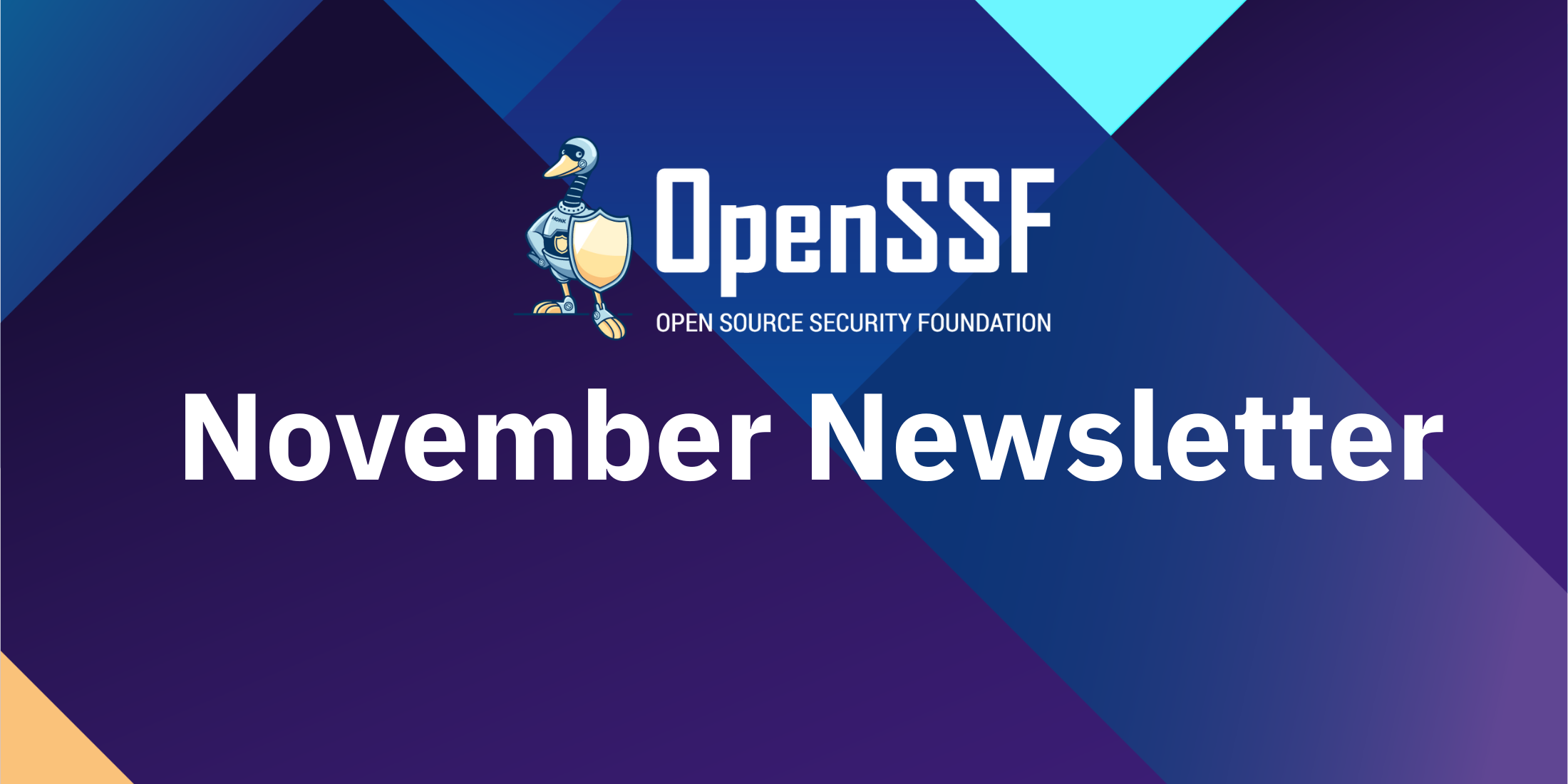
Welcome to the November 2025 edition of the OpenSSF Newsletter! Here’s a roundup of the latest developments, key events, and upcoming opportunities in the Open Source Security community.
✅ Cyber week: Free + discounted security courses to level up fast
✅ EU CRA insights and OSS security guidance from Open Source Security Week in Belgium
✅ OSS security best practices for finance from OSFF NYC
✅ New OpenSSF members, awards, and project milestones
✅ New podcast episodes (#44-45): OSPS Security Baseline and SBOM Chaos and Software Sovereignty
✅ SBOM Coffee Club reviewed OWASP AIBOM
✅ Zarf v0.65.1 adds broader K8s support & hosts Tech talk
✅ OpenBao advancing read-replication
✅ Upcoming events: FOSDEM (31 Jan & 1 Feb 2026), Open Source SecurityCon (23 March 2026), KubeCon+CloudNativeCon Europe (23-26, March 2026)
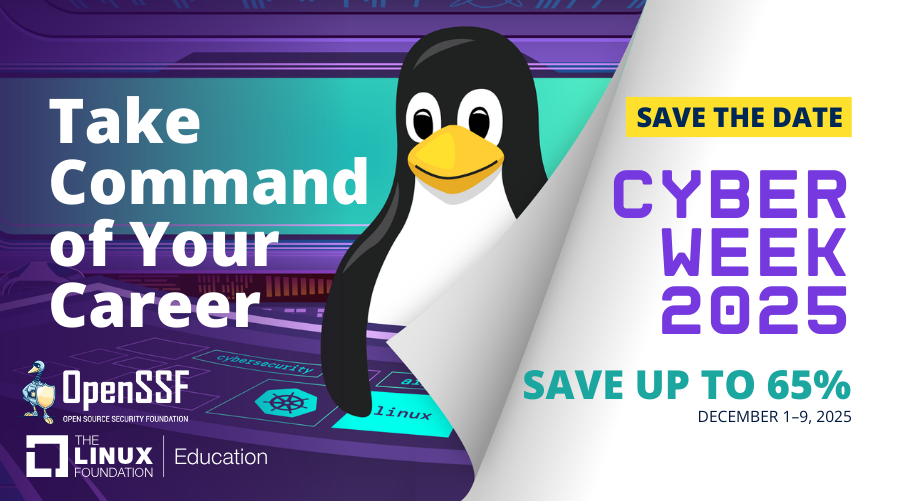
OpenSSF and Linux Foundation Education are committed to making world-class security training accessible to everyone. Whether you are securing critical open source projects, preparing for new regulations, or building foundational expertise, you can start today with free e-learning courses and earn digital badges along the way. Explore offerings like Developing Secure Software (LFD121), Security for Software Development Managers (LFD125), Understanding the EU Cyber Resilience Act (LFEL1001), Secure AI/ML-Driven Software Development (LFEL1012), and many others designed to strengthen software resilience across the ecosystem.
If you are ready to go deeper, Cyber Week kicks off December 1. This brings the biggest savings of the year from Linux Foundation Education. From certification bundles to instructor-led courses and subscription packages, you can save up to 65 percent and accelerate your career heading into 2026.
Visit LF Education starting on December 1st to grab the best savings of the year!
Start learning for free. Level up for less. Strengthen the security of the open source world.

At the end of October, Linux Foundation Europe, OpenSSF, and CEPS hosted a week of open source security activities across Ghent and Brussels. Developers, maintainers, policymakers, and security experts came together to break down the Cyber Resilience Act, share practical readiness guidance, and align on how Europe can strengthen software security without slowing open collaboration. From technical workshops to policy-driven discussions, the week highlighted both the challenges ahead and the growing support available to the community. Read the full recap for key takeaways, reflections, and ways to get involved.
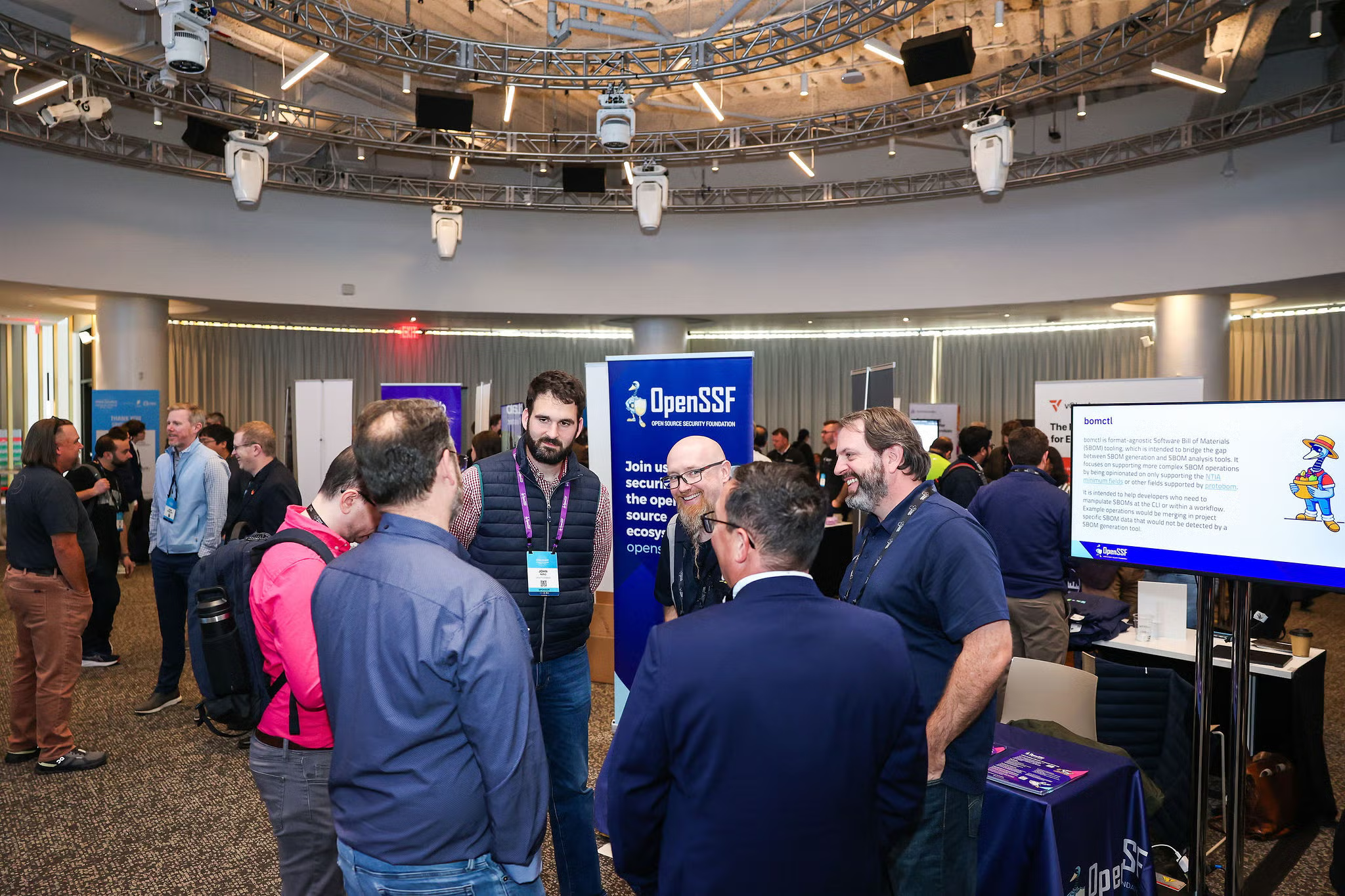
OpenSSF joined the Open Source in Finance Forum (OSFF) NYC to highlight how financial institutions can confidently rely on open source while managing real security risks. Through sessions on AI security, project security baselines, and stabilizing vulnerability data pipelines, OpenSSF showed how collaboration between maintainers, regulators, and industry engineers leads to practical solutions that strengthen the software powering today’s financial systems. Read the full recap to explore the key takeaways and resources shared at OSFF.
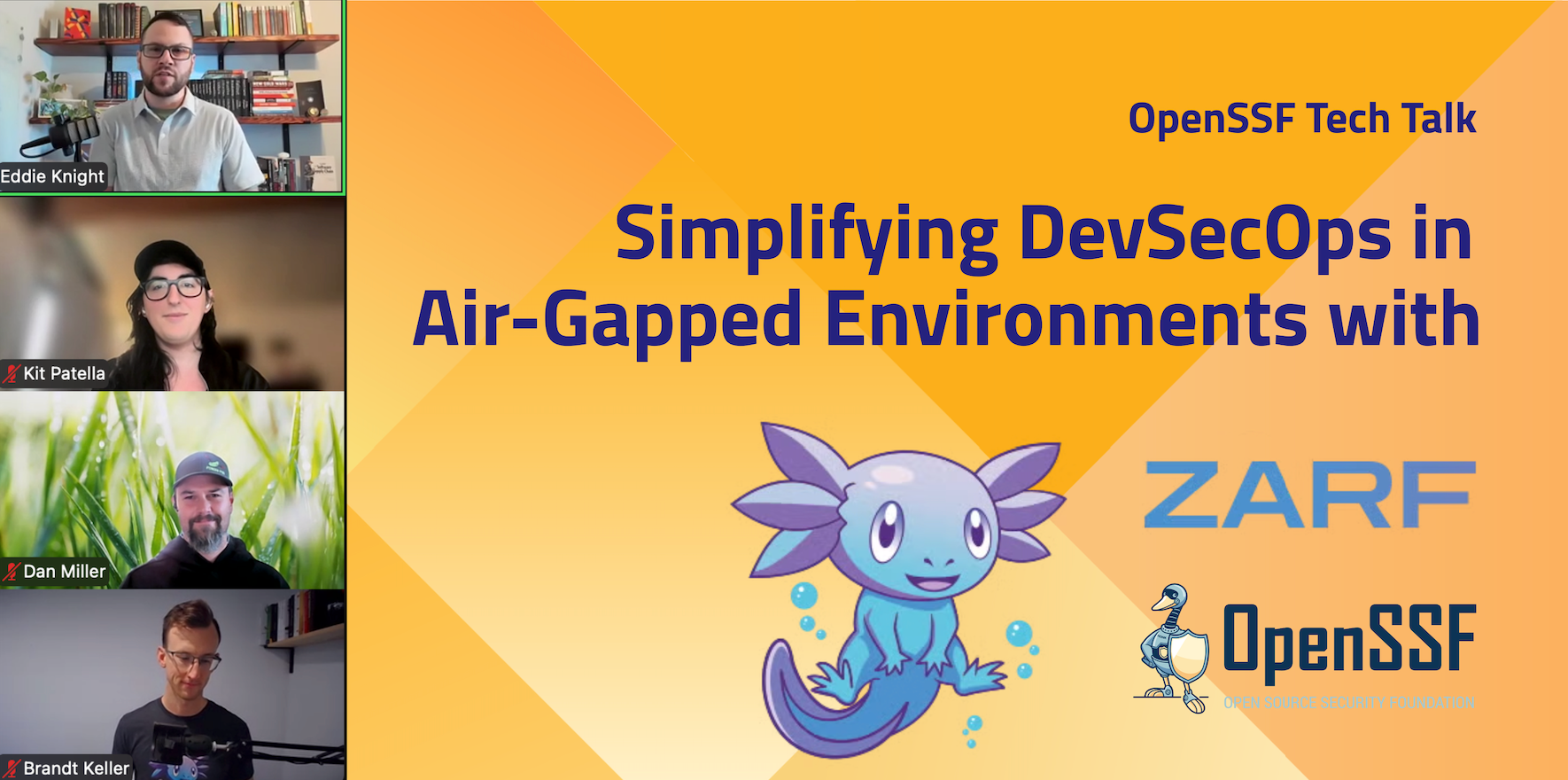
In the latest OpenSSF Tech Talk, we focused on a significant hurdle in software supply chain security: managing software delivery and upkeep within air-gapped and restricted network environments. You can now view the recording on the OpenSSF YouTube channel, and the presentation slides are accessible here.
The Open Source Security Foundation (OpenSSF) announced new and expanded memberships at Open Source SecurityCon North America, welcoming Target Corporation and Thread AI, and celebrating OSTIF’s upgrade to general member status. The community also recognized standout contributors with the latest Golden Egg Awards and highlighted recent progress across learning resources, tooling, and global events. Read the blog to learn more about the membership updates, award winners, and milestones from the past quarter.
Here you will find a snapshot of what’s new on the OpenSSF blog. For more stories, ideas, and updates, visit the blog section on our website.
#44 – S2E21 A Deep Dive into the Open Source Project Security (OSPS) Baseline
In this episode of What’s in the SOSS? CRob, Ben Cotton, and Eddie Knight take a practical look at the Open Source Project Security (OSPS) Baseline, a shared security checklist designed to help maintainers communicate the current state of their project’s security practices. They break down how the baseline fits into real workflows, why clear documentation builds trust, and how downstream users benefit when expectations are aligned. The conversation also explores integrations with other OpenSSF efforts, lessons from the GUAC case study, and what’s ahead as the community continues to refine the framework and expand tooling support.
#45 – S2E22 SBOM Chaos and Software Sovereignty with Canonical’s Stephanie Domas
In this episode of What’s in the SOSS, CRob talks with Stephanie Domas, Chief Security Officer at Canonical, about the hidden challenges shaping today’s open source ecosystem. Stephanie breaks down why third party patches disrupt SBOM accuracy, how software sovereignty is influencing global procurement, and what the EU CRA means for enterprises working with upstream dependencies. She also shares insights on memory safe upgrades in Ubuntu’s next LTS and why transparency, collaboration, and community support are critical to building trust in open source.
Connect with the OpenSSF Community at these key events:
There are a number of ways for individuals and organizations to participate in OpenSSF. Learn more here.
You’re invited to…
We want to get you the information you most want to see in your inbox. Missed our previous newsletters? Read here!
Have ideas or suggestions for next month’s newsletter about the OpenSSF? Let us know at marketing@openssf.org, and see you next month!
Regards,
The OpenSSF Team

Stephanie Domas, Canonical’s Chief Security Officer, returns to What’s in the SOSS to discuss critical open source challenges. She addresses the issues of third-party security patch versioning, the rise of software sovereignty, and how custom patches break SBOMs. Domas also explains why geographic code restrictions contradict open source principles and what the EU’s Cyber Resilience Act (CRA) means for enterprises. She highlights Canonical’s work integrating memory-safe components like sudo-rs into the next Ubuntu LTS. This episode challenges assumptions about supply chain security, software trust, and the future of collaborative development in a regulated world.
00:00 – Welcome
01:49 – Memory safety revolution
02:00 – Black Hat reflections
03:48 – The SBOM versioning crisis
06:23 – Semantic versioning falls apart
10:06 – Software sovereignty exposed
12:33 – Trust through transparency
14:02 – The insider threat parallel
17:04 – EU CRA impact
18:50 – The manufacturer gray area
21:08 – The one-maintainer problem
22:51 – Will regulations kill open source adoption?
24:43 – Call to action
CRob (00:07.109)
Welcome welcome welcome to what’s in the sauce where we talked to the amazing people that make up the upstream open source ecosystem these are developers maintainers researchers all manner of contributors that help make open source great today I have an Amazing friend of the show and actually this is a repeat performance. She has been with us once before
We have Stephanie Domas. She’s the chief security officer for Canonical. It’s a little company you might have heard about. So welcome for joining and thank you for joining us today, Stephanie.
Stephanie Domas (00:45.223)
Thank you for having me again for a second time.
CRob (00:48.121)
I know. It’s been a while since we chatted. So how are things going in the amazing world of the Linux distros?
Stephanie Domas (00:58.341)
Yeah, so just for people who aren’t as familiar with canonical because we do have a bit of a brand thing, we are the makers of Ubuntu Linux. So connect the dots for everyone. So the world of the distros is always a fun place. There has been a lot of recent excitement around NPM hacks, supply chain hacks. And so the world of archives, running archives, running a distro, there’s never a dull moment.
CRob (01:08.422)
Yay.
Stephanie Domas (01:28.475)
So on our distro front, right, we’ve been excited to try and on the security front, focusing on, we’re taking a fresh eye to how to introduce things like memory, save sort of core components into our operating systems. So a sudo RS, so a Rust implementation of sudo is now a part.
CRob (01:40.231)
Ooh.
Stephanie Domas (01:49.085)
Ubuntu will be a part of our next LTS, which is something we’re really excited. We’re looking for more opportunities to replace some of these fundamental components with memory safe versions of them. So that’s also exciting.
CRob (01:52.604)
Nice.
CRob (02:00.167)
That’s amazing. My hat is off to all of you for taking the leadership role and doing that. That’s great. I had the great opportunity to participate in a panel with you recently at Hacker Summer Camp. So kind of, I know it’s been a little bit of time, reflecting back, what was your favorite experience from the Black Hat Def Con, B-Sides, Diana week?
Stephanie Domas (02:24.609)
Yeah, and so I’m always one of those people who one of my favorite things is just the ability to reconnect with so many people in the industry. That’s the one time of year where actually despite the fact that you and I physically live near each other, that actually tends to be the one time a year we see each other in person. so extending that to all of just the great people I’ve known in the industry and getting to see them. The panel you spoke about was another real highlight for me. So the panel for those who didn’t get the privilege of attending wasn’t asked me anything on open source. And it was great because there was such a variety of interests right there. People who are interested in what it’s like to be a maintainer. What does it mean to use open source in enterprise? What does it mean to try and think of monetization models around open source? And so the diversity of conversation, which is really exciting to find people who are in the space really unfamiliar with open source or trying to figure out how do I reason about it and to be able to have those conversations with them was really exciting for me.
CRob (03:24.515)
I agree, I thought that was a great experience and I would love to see us do that again sometime. Excellent. Well, let’s move on to business. Today you have some things you’re interested in talking about. So let’s talk about one of my favorite topics, a software bill of materials and also talking about sovereignty within software.
Stephanie Domas (03:29.725)
I’ll put in a good word.
CRob (03:48.867)
From your perspective, how are you seeing these ideas and the tooling around SBOM, how are you seeing that adopted or used within the ecosystem today?
Stephanie Domas (04:00.421)
Yeah, so I will say, I’ll preface it with SBOMs continue to show a lot of really great promise. I do think there is a lot of value to them. I think they’re really starting to deliver on some of those benefits from trying to implement them at scale, right across our entire distro, across the archives, right? There are still some implementation challenges. So one of the things that’s been on my mind a lot recently is around versioning.
CRob (04:28.273)
Ooh.
Stephanie Domas (04:29.863)
So I feel like every week I see some new vendor or I get approached by some vendor whose business model is to create patches for you on the open source that you use to help maintain your security.
It’s a really interesting business proposition. get why these companies are popping up. But when I start to think of S-bombs and some of the difficulty we’re having around implementing them, this idea of version control in open source, when we have companies coming out of the woodwork to create patches, just creates this swirl of chaos.
To add some more, to add a specific example around there, you think about semantic versioning, right? When we release the version of something, it’s 5.0.0. When we release a patch, when the original manufacturer, the upstream releases a patch, it’s 5.0.1, right? Then 5.0.2. And so S-bombs come into play because the S-bombs goal is to understand the version of the thing that is inside of your piece of software. And then it uses that to kind of look up and say, hey, what are any known security issues in this version. But as I continue to see and have even talked to some of these businesses whose whole value proposition is, we will actually maintain and develop patches for you for the things that you are using, you’re breaking this whole idea of semantic versioning that now you are potentially carrying a tremendous number of patches for security specifically that aren’t representing that versioning number. And so then the question becomes like, what do you do with that? If I’m using internally 5.0.0 and I’ve used one of these companies to develop a security patch for me, what does that mean to my version number? What do I put in my S-bomb when I have created my own security patches that I have chosen not to upstream? What does that mean? And so…
Stephanie Domas (06:23.931)
I see this as a really unique problem to open source, right? Where there’s, there’s a lot of upsides to open source, like the tremendous amount to be specific, but the code base being open and allowing people to develop their own patches now creates this slurry of confusion of, don’t think version numbers will be the thing we can rely on in S bonds. And I don’t know what the answer is, right? I don’t actually, I don’t have a good approach to this when we’re starting to see, you know, customers using these companies create their own patches, they use some internal vulnerability scanner, and then they come back to us and say, hey, there’s these problems, these reports I’m getting from my scanner that’s scanning my S-bombs, and we’re sitting there confused of like, but because you’re carrying these other patches, I mean, it’s causing so much confusion where inside of the company, they don’t even realize. And so they get these scanning reports, so they come to us. They’re like, well, I don’t know how to answer this question because you’ve done something else internally, which is great. You like that, but your risk position, you’ve hired one of these companies to give you patches. So it’s one of these interesting things that’s been on my mind recently of, don’t know what the answer is, but I think SBOM’s inversion control and open source is going to be a really big struggle in the coming years as we see more of these offshoots of, of patches and security maintenance coming from not upstream and with no intention to upstream them.
CRob (07:50.415)
And I think, you we talk, get to deal with a lot of global public policy concerns and thinking about like the CRA where manufacturers are, have a lot of pressure to produce these patches. They’re encouraged to share them back upstream, but they’re not required. So I imagine the situation that you’re describing where these vendors are kind of setting up this little cottage practice.
You’re only going to see more of that. again, it’s going to cause a lot of confusion for the end users and a lot of, I’m sure, frustrated calls to your support line saying, I’m using package one, two, three, well, the actual, canonical version, pun intended. Ours is XYZ. Again, I bet that would cause a lot of customer downstream confusion.
Stephanie Domas (08:39.579)
Yeah, the EU CRA is one of the forcing functions that I think will bring a lot of this to light is where you start to have these obligations around patching and add a testing to this to your customers. But then again, you start to get this.
untenable spaghetti muster. How is that virgining happening when that manufacturer has potentially again use one of these businesses to create patches internally that they did not upstream. And so what does that mean for the S-bomb of the users when you give that to the users? How are they supposed to make informed risk decisions about that when the version number in that S-bomb is either follows upstream, in which case it misrepresents the security posture or they’ve come up with their own versioning system that’s unique to the internal patches that they’re carrying. And so again, the poor users are left without being able to make those informed decisions. So yes, the EU CRA, one of my favorite topics, is it’s gonna be a forcing function for that. And I think it’s gonna…
Again, there’s no answers. Like I think we’re going to be forced to try and make some of these decisions about like, what, what does that mean? Right? How do you, how do users reason about their SBOMs when the version numbers in them may not make sense anymore.
CRob (09:53.423)
It’s good to know that you’ve jumped into one of the hardest problems in software engineering, versioning. Do you want to tackle the naming issue as well while we’re at it?
Stephanie Domas (10:03.205)
I’m here to solve all, actually I’m just here to call out the problems.
CRob (10:06.247)
So somewhat adjacent, you mentioned that you wanted to talk about kind of this trend in the ecosystem around sovereignty. The EU thinks about it as digital sovereignty, but we’ve seen this concept in a lot of different places. So what are some of your observations around this, air quotes, new movement?
Stephanie Domas (10:32.121)
Yeah, so sovereignty is a really interesting one. For those who haven’t been too exposed to it, we’re seeing a big push in things like data sovereignty, which is focused on where is my data, right? Is my data contained in some, name some geographical border?
The big one that has been coming up for me a lot recently is software sovereignty. So there are some countries and some regulations that are taking the approach that the way to drive trust in a piece of software is by where it was developed, where the developers that wrote that piece of code come from. And on a surface, I…
I can see why they’re thinking that, right? I don’t necessarily agree with that. I can see why they may be thinking, hey, if this software was developed by people with the same ideals as me, maybe I can assume that it is for the same purpose that I agree with, right? I can see that argument, but I don’t love that argument. So the thought process to me is, is this actually the most effective path to true security, right? What they’re trying to achieve through this focus on software sovereignty is in fact more trust in the software. And being economical, right? That our solutions are open source, right? When this has come up for me for ambitions to sell to different federal governments, right? And so I sit in these conversations where contractors and consultants are trying to explain to me like, well, here’s what you have to do to sell to this name federal government here.
And you sit there thinking like, none of this makes any sense for open source. It’s kind of the antithesis of it, right? Attestation that the code was only worked on by people in certain countries. And I keep sitting there thinking, this is a wild way to derive trust in software. And so I sit there asking myself, why is this happening, right? On one side of the fence, there’s the, yes, I derived trust in software by who developed it.
Stephanie Domas (12:33.157)
The other side of that and the side that I think open source solves is, it not a more robust defense, right? To not think about national borders, but instead globally accessible and audible code bases. And again, they’re in these meetings. So CMMC was a reaching one for those in the U S but they have them in all over the world sitting there thinking like there’s absolutely no way for me to achieve anything beyond level one in CMMC because I can’t and have no interest in attesting to build pipelines that are only from certain citizens. And again, it’s one of these where it’s it’s confusing to me. So it’s been on my mind sitting there in these meetings about this and support sovereignty, right? Support sovereignty has actually come up as well for us. We have experience not just governments, but customers now who are seeking support to only be performed by people in name geographic border. And so we’re having to try and develop strategies again around support sovereignty. And again, I go back to if the codebase is globally accessible and auditable, I just feel like that’s a better way to solve this problem of deriving trust in what is done in the software, even from a support perspective, if you want to derive trust in what changes they’re proposing, what code they’re proposing to you. The fact that you can see it all should be how you derive trust, not where that person is physically sitting in the world. So that’s me on my snowboard. Sovereignty for the moment.
CRob (14:02.611)
And I, I like in this movement to back when I was an in-house practitioner in a InfoSec team, that the business always was dismissive of the insider threat vector. The fact that they were so focused on external actors that these, that somebody’s going to come in and hack the organization. But you look at reports like the Verizon data breach report that comes out every year and consistently every year, the most damaging cybersecurity breaches are people outside of your organizational trust boundary. And that’s, know, they cause the most damage. They are the most frequent, whether it’s ignorance or malice, you know, the, the, is the root cause of the problem, but it’s still someone inside of your organization. And to extrapolate that from a nation, you’re going to have a much broader spectrum of people, even outside of the, your small enterprise. So I always thought I was kind of scratched my head why people were so dismissive of this because there’s evidence that shows that the insiders are actually the ones that can cause that have consistently caused the most damage and then when you blow that up.
Stephanie Domas (15:11.773)
And I can tell you, yeah, as someone who spent time as an adjunct professor at The Ohio State University teaching software development.
There’s a lot of not great coders out there, right? So even if their ideals align, even if like there is nothing associated with code coming from a domestic location, it ensures quality, right? Again, even if you’re not worried about malice, there’s a lot of bad developers out there. The ability to have a portable code base should be your number one focus. And so yeah.
CRob (15:46.119)
And it’s the whole, have the thousand eyes, transparency perspective. But what I’ve always loved about open source is the fact that it’s meritocracy based. That, you know, the best ideas get submitted. have, we are able to pull ideas from everywhere that, know, anyone’s idea is potentially equally as valid as everybody else’s. So I love that aspect and that makes the software stronger because it helps ideally.
Coach those developers like you alluded to that might not be as skilled or as aware of security techniques and ideally helps them improve themselves, but also helps ideally not let those bad commits get into the code.
Stephanie Domas (16:25.777)
Yeah, and I’ll be the first to admit that not all open source is quality, right? It’s a variety of things. But the point is that you have the ability to determine that yourself before you choose to use the code. So depending on your risk posture, you get to make that decision.
CRob (16:43.43)
Mm-hmm.
Absolutely. So again, kind of staying on this topic, from your perspective and like the developers and then the customers you get to work with, how has this new uptick of global cyber legislation impacted your mission and impacted your customers?
Stephanie Domas (17:04.698)
Yeah, so I’ll actually I’m going to circle back to our favorite legislation, which is the EU CRA. So this has been a really interesting one because it’s.
CRob (17:10.01)
Yay!
Stephanie Domas (17:15.549)
It’s forced a lot more light, I think from the customers we’re working into the open source they’re using, how they’re consuming it and putting a lot more intentionality into if I continue to consume it this way, what does that mean for my, my liability associated with this piece of code? So in a way it’s been really good that it’s forcing customers to think more about that. As you mentioned earlier about patching and thinking about how am I getting this patch? How am I incorporating this patch? Part of the EU CRA is requiring for security patching for the defined lifecycle of the device. And again, that’s actually driving some really interesting conversations about, okay, yeah, that makes sense for the piece of software I wrote, but I had these pieces that I was consuming in the open source space and what does that mean for these? And so I do think it’s driving a good conversation on what does that mean? I worry that there is still some confusion in the legislation and until we get the practice guidance, we won’t have the answers to around that enterprise consumption of open source. And what does that mean from my risk perspective, right? If you consume so, and I’ll also caveat. like there is a carve out in the EU CRA for open source stewards. Canonical is defied, we make open source, but we are not actually an open source too, right? Because we have monetization models around support and because we want to support our customers, we are actually considered a manufacturer. So we’re taking a manufacturer role. So a manufacturer role over open source is also kind of a big gray area in the practice guidance and the legislation of like, well, what does that mean? Because again, despite the fact that we’re taking manufacturer on Ubuntu, the amount of upstream dependencies of us is astronomical. And so what does that mean? Right? What does that mean for us taking liability on the Debian kernel? I don’t know.
It’s bit confusing at the moment of what that means because we are in fact in manufacturer consuming open source. then to our customers who we have business relationships with, right? We are signing CRA support clauses, right? We are giving them, we are taking manufactured. They don’t have to take manufacturer on the open source they consume from us. But again, it’s a bit unclear of what entirely that means. We are actively involved in things like the Etsy working group that is defined some of these practice standards, particular and operating systems and Ubuntu is one of our flagship products. So we’re involved in that, that working group to try and define like, what exactly does this mean for operating systems? But despite being best known for Ubuntu, we actually have a very large software portfolio. And there’s a lot of software in our portfolio that doesn’t have a vertical practice guidance being made. And so this like general horizontal one that would define the requirements for those products not really see much activity on that yet. So there’s also big unknown around. don’t know what those expectations are for our products right now, which again, have tremendous upstream dependencies. And in some case, we are a fraction of that code base, right? What canonical produces in that code base is a fraction of the overall code base. But when people consume it through, what does that mean? Because we took the manufacturer role on it.
CRob (20:33.415)
Yeah. Well, and you touched on it a little bit earlier that all open source is amazing. Not all of it is great software. It’s a big spectrum. You look at a student project or someone running an experiment that you stumble across on GitHub is a very different experience than like operating with Kubernetes or the Linux kernel or anything from like the Apache foundation. like when you have these large mature teams, they have a lot of different capabilities as opposed to random project you find on the internet that somebody might not have intended for it to be commercialized.
Stephanie Domas (21:08.416)
Yeah, and I was reading an article recently on, I think it was an NPM archive that they had done their statistical analysis on, but they had done all this interesting analysis on the number of essentially the number of different handles who had committed to a piece of software and their overall conclusion right was that.
CRob (21:23.911)
Mm-hmm.
Stephanie Domas (21:26.301)
The majority of open source was one maintainer on this archive, right? That they showed of the, you know, N number of most popular downloads over 50 % of them. And I can’t remember the number. It might’ve been something closer to 80 % was one person. And so again, it’s not open source has a lot of amazing things. Not all of it is well written, not all of it is well maintained. so again, it’s sort of forcing regulations like the EU CRA are forcing people to take a much better look at their supply chain to understand, you know, where am I consuming that from? that something that is well maintained? Because I can’t just take the old version, say it’s stable and not worry about it from there. Can’t do that anymore under the CRA. I have to do security patching on this thing and now I’m potentially responsible for it and what does that mean? I do worry and I hope that we won’t see a recoil of enterprises using open source because of that fear, right? Because there are large libraries out there where there aren’t people willing to step up and take the maintainer role on them. And that makes enterprises afraid to consume those products under the EU CRA. And so that’s a fear that I do have. And again, it’s because it’s a bit of a gray area about how the liability, if that open source repo decides to take steward status, what does that mean for the enterprise consuming that? If it’s something small, it’s a tiny library, maybe the risk isn’t large, but it may be a really meaningful part of the application.
And if there’s no, if you’re not consuming it through somebody willing to take manufacturing role in your chain, will you still be willing to consume that piece of open source? So I do worry about that. I hope that as the practice guidance comes out, that is clarified so there’s better understanding of what that means and we won’t see that recoiling. But I have tried to talk to some of the legislators that are working on that and actually they haven’t been able to answer that question for me yet either. Is there going to be clarification because this is an area of concern. So hopefully between now and more practice guidance, we get more clarification so we don’t see that recoiling.
CRob (23:34.915)
And I know that at least from the horizontal and vertical standard standpoint, we are very close to starting to get public drafts being able to be delivered sometime fourth quarter in 2025. And ideally that’ll allow us to see what the legislators are thinking and where they are planning on landing on some of these issues. And hopefully we get some clarifications. And ideally we get the chance to provide feedback and say, hey, great work.
But have you considered X, Y, and Z to help make this more precise and more clear?
Stephanie Domas (24:11.387)
Absolutely, and my understanding that, hopefully I’m remembering the numbers correctly, I think there’s 15 vertical standards being written in Etsy right now. And so while that’s an astronomical amount of practice guidance, so like tremendous amount of work being done, that still won’t cover all the products. And so there’s still going to be a tremendous number of products that are sitting outside of those 15 vertical standards. And so again, the question will be like, but what does that mean for all the other products that are not in these 15?
CRob (24:43.431)
So as we wind down, what thoughts do you have? What do you want our audience to take away? What actions would you like them to take based off this conversation?
Stephanie Domas (24:55.825)
Yeah, depending on your role in the space. mean, I’m going to go ahead and plug open SSF, right? So the issues that we talked about, like what does SBOM mean as open source starts to become divergent, right? All of these things, I think will only be solved in organizations like the open SSF, right? Who has this bringing all the collective parties together to think about what it means. Same with some of these gray areas I mentioned about in the EU CRA and what does that mean? We need those types of organizations. if anyone listened to this and was like, well, maybe I have ideas on how to solve because all Stephanie did was complain about the problem, but I want to be a part of the solution. Look at joining the organizations like OpenSSF. That’s where the solutions will come from. Right. I can see my side of the problem, but I can’t, I can’t, even if I had ideas, I can’t independently solve it. Organizations like OpenSSF can do.
CRob (25:44.902)
Right.
It’s very much a community set of issues and I think collectively we’re stronger in having a better solution together. My friend, I need to arrange an ice cream social event in the near future before we’re covered in snow. But thank you for your time Stephanie and thank you to you and the team over at Canonical for all your hard work. with that, we’re going to call this a wrap. Thank you everybody.
Stephanie Domas (25:56.805)
Agreed.
CRob (26:17.019)
Happy open sourcing out there.